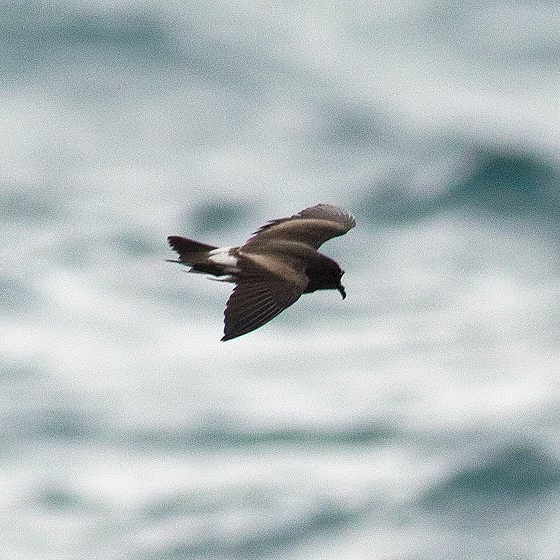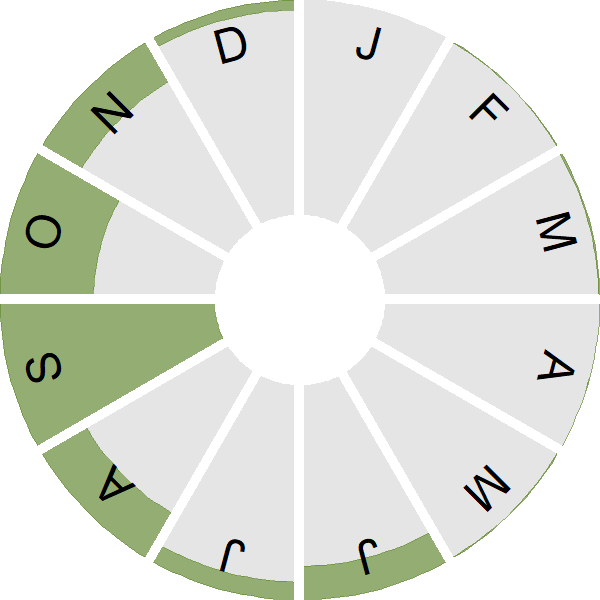Leach's Petrel

Introduction
This is the most marine of our breeding birds and a difficult species to see, visiting its underground nests at night and spending the rest of the time at sea.
Leach's Petrel has a more restricted breeding distribution within Britain & Ireland than the more familiar Storm Petrel, its colonies all located within 70 km of the Atlantic continental shelf. While significant numbers breed at colonies on remote islands far off the coasts of Scotland and Ireland, our population is small compared to those off North America.
As with other burrow-nesting seabirds, the species faces a threat from mammalian predators inadvertently introduced to islands. Leach's Petrels may also be taken by avian predators, which is one reason for their nocturnal habits at breeding sites.

Key Stats
Identification
ID Videos
This section features BTO training videos headlining this species, or featuring it as a potential confusion species.
Petrels
Songs and Calls
Call:
Alarm call:
Status and Trends
Conservation Status
Population Change
This species nests in burrows and is difficult to survey and the first full Census was carried out during the 1998–2002 Census (Seabird 2000) using tape-playback techniques. Subsequent surveys at two UK colonies suggest that declines have occurred, included a 54% decline at the largest UK colony at Dun (St Kilda), which held around 58% of the UK population at the time of the Seabird 2000 surveys.
Distribution
Leach's Petrel colonies are limited to remote, offshore islands in the far north and west of Scotland and Ireland, close to the deep-water areas beyond the continental shelf where they are thought to feed. Outside the breeding season they can sometimes be seen from coastal headlands and seawatching hotspots during autumn and early winter gales.
Occupied 10-km squares in UK
2007/08–10/11
or view it on Bird Atlas Mapstore.
2008–11
or view it on Bird Atlas Mapstore.
Distribution Change
Change in occupied 10-km squares in the UK
from 1981–84 to 2007–11
or view it on Bird Atlas Mapstore.
from 1968–72 to 2008–11
or view it on Bird Atlas Mapstore.
Seasonality
Leach's Petrel is a very localised breeder, though is rarely seen during the breeding season. Most records are in autumn and come from storm-blown individuals on the coast and occasionally inland.
Weekly pattern of occurrence
The graph shows when the species is present in the UK, with taller bars indicating a higher likelihood of encountering the species in appropriate regions and habitats.

Movement
Britain & Ireland movement
Foreign locations of birds ringed or recovered in Britain & Ireland
Dots show the foreign destinations of birds ringed in Britain & Ireland, and the origins of birds ringed overseas that were subsequently recaptured, resighted or found dead in Britain & Ireland. Dot colours indicate the time of year that the species was present at the location.
- Winter (Nov-Feb)
- Spring (Mar-Apr)
- Summer (May-Jul)
- Autumn (Aug-Oct)

European movements
EuroBirdPortal uses birdwatcher's records, such as those logged in BirdTrack to map the flows of birds as they arrive and depart Europe. See maps for this species here.
The Eurasian-African Migration Atlas shows movements of individual birds ringed or recovered in Europe. See maps for this species here.
Biology
Productivity and Nesting
Nesting timing
Egg measurements
Clutch Size
Survival and Longevity
Survival is shown as the proportion of birds surviving from one year to the next and is derived from bird ringing data. It can also be used to estimate how long birds typically live.
View number ringed each year in the Online Ringing Report.
Lifespan
Survival of adults
Biometrics
Wing length and body weights are from live birds (source).
Wing length
Body weight
Ring Size
Classification, names and codes
Classification and Codes
- Order: Procellariiformes
- Family: Hydrobatidae
- Scientific name: Hydrobates leucorhous
- Authority: Vieillot, 1818
- BTO 2-letter code: TL
- BTO 5-letter code: LEAPE
- Euring code number: 550
Alternate species names
- Catalan: ocell de tempesta boreal
- Czech: burnácek dlouhokrídlý
- Danish: Stor Stormsvale
- Dutch: Vaal Stormvogeltje
- Estonian: põhja-tormipääsu
- Finnish: myrskykeiju
- French: Océanite cul-blanc
- Gaelic: Gobhlan-mara
- German: Wellenläufer
- Hungarian: villás viharfecske
- Icelandic: Sjósvala
- Irish: Guairdeall Gabhlach
- Italian: Uccello delle tempeste codaforcuta
- Latvian: ziemelu vetrasburatajs, cice
- Lithuanian: šiaurinis audrašauklis
- Norwegian: Stormsvale
- Polish: nawalnik duzy
- Portuguese: painho-de-cauda-furcada
- Slovak: víchrovnícek severský
- Slovenian: viharni strakoš
- Spanish: Paíño boreal
- Swedish: klykstjärtad stormsvala
- Welsh: Pedryn Drycin Leach
Research
Causes of Change and Solutions
Causes of change
The causes of change are unclear and the extent of the suspected decline is uncertain until the full results of the Seabirds Count (2015–2021) are published. However, predation (by Great Skuas and Great Black-backed Gulls) has been suggested as one possible cause of decline (REF FROM JNCC WEBSITE). Other factors could be contributing to decline and further investigation is needed.
More Evidence
More evidence from Conservation Evidence.com
Partners
Citing BirdFacts
If you wish to cite particular content in this page (e.g. a specific value) it is best to use the original sources as linked in the page. For a more general citation of the whole page please use: BTO (20XX) BirdFacts Species: profiles of birds occurring in the United Kingdom. BTO, Thetford (www.bto.org/birdfacts, accessed on xx/xx/xxxx).

